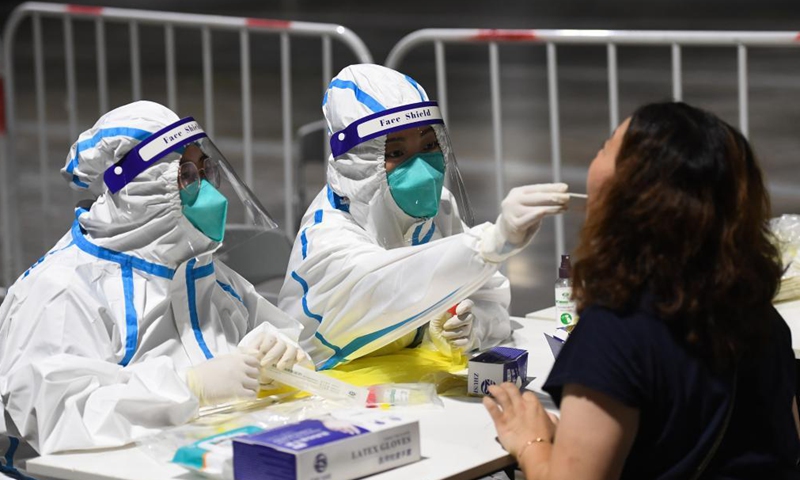
A medical worker takes a swab sample from a woman for COVID-19 test at a testing site in Nanjing, east China's Jiangsu Province, July 21, 2021.Photo:Xinhua
The latest COVID-19 surge with the Delta variant detected in Nanjing, East China's Jiangsu Province, whose scale may be similar to or larger than the previous outbreak in Guangzhou, is expected to end in mid-August after two longest incubation periods, said Chinese experts.
Local authorities said that the Delta variant was detected in the latest epidemic spike in Nanjing as it reported 31 new locally transmitted cases on Tuesday, bringing the total to 112, including 106 confirmed cases and six asymptomatic ones.
Most of the newly reported cases were detected in key management areas and were related to the Lukou Airport, where infections were first found. A third round of nucleic acid testing has been rolled out in related districts, city health authorities said during a press briefing.
Nanjing has mapped out plans to enhance anti-epidemic measures, including suspensions of businesses operating in enclosed areas like KTVs, cinemas and gyms, as well as limiting people flows to markets and shopping malls.
The Delta variant has been detected in the latest spike, with better adaptability to the human body, faster transmission speed and a higher viral load. Patients infected with the variant are more likely to have severe symptoms, authorities said.
An anti-epidemic expert who requested anonymity believes that the scale of the latest outbreak in Nanjing may be similar to or even larger than the previous epidemic surge in Guangzhou, South China's Guangdong Province, where cases infected with the Delta variant were found in late May.
The expert predicted the total number of cases in Nanjing and spillover cases could reach about 250 and end in mid-August after two longest incubation periods.
Yang Zhanqiu, a deputy director of the pathogen biology department at Wuhan University, said that the 17 patients, who were all cleaning staff at the Nanjing Lukou International Airport and tested positive for COVID-19 as of July 21, were likely to be associated with imported cases as they could have been exposed to materials contaminated by imported patients.
Some experts blamed poor management of the airport, which could have resulted in the virus spillover.
Cases surged during the week since those patients tested positive, in line with the transmission behavior of the variant, which has a short incubation period - usually about four days in average, Yang told the Global Times on Tuesday. The short incubation means that the virus can infect more people for every unit of time, which calls for a more immediate response against the infection.
Yang predicted that cases in the upcoming days are expected to decrease.
The city dialed up epidemic risk levels on Monday, bringing the number of high-risk areas to four and medium-risk areas to 25.
Entrances and exits for all residential communities in Nanjing are being strictly controlled, with bans on all packages or food deliveries.
Starting from Tuesday, the city has suspended the operation of eight long-distance bus stations, as well as its tour bus services. Some 19 bus lines that had routes traveling to adjacent areas are now limited within the city, and taxis may not leave the city.
The Nanjing government on Monday afternoon vowed to "stamp out" the epidemic within one to two incubation periods. The priority of the anti-epidemic work is to clear the existing cases, and prevent further transmission in Nanjing and more spillovers out of the city, the local government said.
Besides, five provinces and nine cities have reported cases related to the Nanjing flare-up, including Guangdong, Southwest China's Sichuan, East China's Anhui and Northeast China's Liaoning provinces.
Yang said the emergence of sporadic cases in some areas is inevitable as the variant has developed to be more tolerant of new environments. First detected in India, which is mostly tropical, the variant has become more tolerant of high temperatures, Yang explained.


